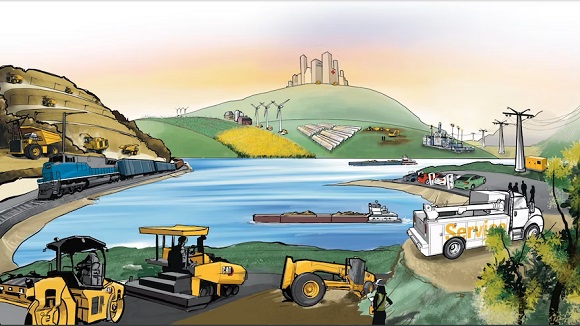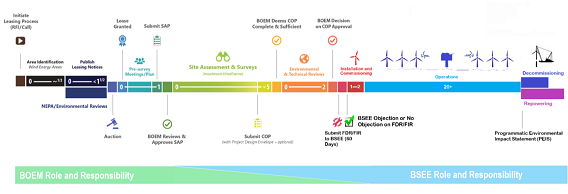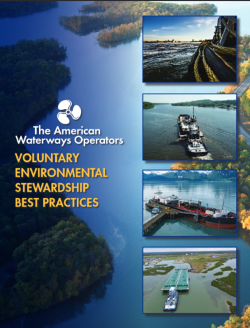Navigating to Zero - April 26
04/27/23
We Can Be HEROes
The American Waterways Honor & Excellence in Rescue Operations (HERO) Award recognizes rescues undertaken by AWO member company employees that demonstrate selflessness, skill, and bravery. AWO launched the program on March 1 of this year, recognizing our first awardees in Houston during the Safety Committees’ Winter Meeting. Since then, we have received several additional submissions, sharing the great things our mariners are doing every day to protect themselves, their crews, the environment, and the communities in which they operate.
Awardees receive a certificate for their vessel and a commemorative coin for each member of the crew involved in the rescue. Details about how to submit a nomination for the HERO Award and the submission form can be found on the AWO website. Please help us thank and shine a spotlight on our industry’s heroic mariners by sending in a nomination.
Congratulations to these recent recipients of the American Waterways HERO Award:
- Norfolk Tug Company - Crews of the Paula Atwell and Robert Burton
- SCF Marine – Crew of the SCF Endeavor
- Stasinos Marine – Crews of the Charles James and Eastern Dawn
- Crescent Towing – Crew of the Lisa Cooper
- Kirby Inland Marine – Crew of the Drum Point
- Amherst Madison, Inc. – Crew of the Mary Ellen Jones
- Genesis Marine – Crew of the Margaret Anne
- Kirby Inland Marine – Crew of the M/V Lampasas
AWO Safety Committees’ Winter Meeting, Houston: More Key Takeaways
Last month’s edition of Navigating to Zero included highlights from the AWO Interregion and Coastal Safety Committees’ Winter Meeting in Houston. This month, the Safety Committees are proud to share additional key takeaways from the meeting.
AWO members can access all the Winter Meeting’s presentations on AWO’s Resources webpage.
 |
Future of Training Panel
Leading maritime training providers Peter Frankel of Marine Learning Systems, Paul Cyr of Helm Operations, Jonathan Burson of Seamen’s Church Institute, Bob Stout of Moxie Media, and Jon Kjaerulff of MITAGS shared their insights on how training is evolving and improving. Here are the highlights of the discussion:
- Bob and Paul discussed the value of blended training to help new mariners develop their knowledge and skills, using both classroom instruction and practical teaching “on deck” in a safe environment, like a barge moored to shore or a simulated deck area set up on land but designed to look and feel like a real barge.
- The panelists discussed how engagement tools like gamification – a structure of training that allows trainees to earn points or badges for success – appeal to a younger generation that is very familiar with video games and provide both entertainment and educational value. Using another emerging technology, virtual reality (or VR), both new hires and experienced mariners can learn to conduct remote assessments using virtual tools, which can make real-world operations more efficient – for example, a barge going to dock can undergo a virtual assessment en route to the terminal to save time when it arrives on dock for discharge. All of the panelists agreed that personal electronic devices (smart phones) are emerging as a preferred method of delivering training, and because of this, training should be designed to work on both a computer and mobile device whenever possible.
- Peter, Jon, and Jonathan talked about the importance of putting accident investigations and reports, safety alerts and recommendations, and other guidance from the Coast Guard and National Transportation Safety Board to good use by incorporating them into training to prevent similar incidents in the future. Jon suggested presenting mariners with real-world incidents and asking, “What would our organization do in the case of an emergency like the example?” Jon and Jonathan both discussed the advantages of putting a real-world incident into a simulator for training, as it provides a realistic scenario and has a known outcome that can be compared to the simulated outcome to look for opportunities for improvement.
- The panelists agreed that pre-hire assessments can help identify candidates that will fit the role and give the hiring manager an idea of the candidate’s level of experience. Bob suggested making a short film about the robustness of your training program to show that your organization values training and is willing to invest in people, which are signs of a strong safety culture. Jonathan recommended showing off the “cool” things we do, like using simulators, to ensure our captains and officers receive the best training available.
Focus on Tankermen
Tankering and Barge Operations Subcommittee Chairs Josh Dixon of PSC Group and James Loughlin of Midwest Tankermen delivered an engaging talk using scenes from the Indiana Jones movies to illustrate how tankermen’s work can be as dangerous and heroic as the fictional character’s adventures. The presentation highlighted how tankermen face daily tasks and challenges that put their safety at risk, such as working in extreme environmental conditions, balancing pressure and flow rate to avoid unintentional release of chemicals, contorting into uncomfortable positions to connect parts of certain barges to loading arms, and being provided with unsafe means to access the barge. However, unlike Indiana Jones, tankermen do not enjoy the benefits of stardom and fame. For that reason, Josh and James emphasized the importance of safety leaders pushing for improvements in tankermen safety, which is the goal of the Tankering and Barge Operations Subcommittee.
Distracted Operations Deckhand Training Guide
Cody Sanders of Canal Barge Company presented the latest work product of the Subcommittee on Distracted Operations (DISTOPS), which was formed in 2019. DISTOPS previously developed the Sterile Wheelhouse Guide, which provides best practices for when and where wheelhouse personnel should avoid using communication devices, especially during critical maneuvers or jobs. The Subcommittee’s newly published Deckhand Training Guide simplifies the topic of managing distractions by listing the top eight most critical tasks deckhands perform and specifying the things they should be doing and the things they should avoid during these events. Cody shared examples from the training document, which (together with the previous guide) can be downloaded from AWO’s Resources webpage.
Don’t forget to start making plans to join AWO’s Interregion and Coastal Safety Committees on August 16-17 in St. Louis for our Summer Meeting, which will showcase the work of the Falls Overboard Subcommittee and feature a presentation from the Maritime Administration about a new near miss reporting initiative, a presentation from Caterpillar® on sustainable marine engine technology, and much more.
Safety Professionals’ Corner
 |
Ms. Angie Fay
Angie Fay is Vice President of HS&E and Compliance for Blessey Marine Services, Inc., where she spearheaded development of Blessey’s industry-leading safety management system and well-respected vetting program, and coordinated the implementation of Subchapter M. She previously served as Chair of the AWO Interregion Safety Committee and is currently Chair of the AWO Distracted Operations Subcommittee, a member of the AWO Safety Leadership Advisory Panel, and a federally appointed member of the National Towing Safety Advisory Committee. Angie is certified as a Lead/Internal Auditor for ISO 9000, the ISM Code, and AWO’s Responsible Carrier Program.
What are your safety program priorities for 2023?
Blessey's commitment to safety is an essential part of our business philosophy. Safety is not only good for business, but it is also a core personal value for each member of our team. We believe that every person's safety is their ultimate responsibility, and we provide the necessary resources to help them grow their safety knowledge and skills.
Like other towboat and barge operators, we have an active Stop Work Authority program. To ensure that our mariners understand our commitment to their safety, we are re-introducing our "Stop Work Warrior" program, which we put on hold during the downturn and COVID pandemic. Our Stop Work Warrior program celebrates our mariners who utilize their Stop Work Authority in high learning value events. We recognize and reward individuals who report unsafe conditions through this program and are revamping our safety awards program that will recognize the many other great things our employees are doing to stay safe, including completing training on schedule and taking other proactive steps to stay safe at work and at home.
Another focus this year is on drills. We are looking at fire, falls overboard, and our other safety, security, and environmental response training we have developed for our operations. We use drills to educate and prepare for when things go wrong. Blessey is committed to continuous improvement, and by focusing on drills and exercises, we can show that commitment and ensure our mariners are prepared to respond to real-life emergencies.
We are also getting back to basics by promoting things like stretching before work. Many of our mariners work out and they prepare their bodies for exercise by stretching and eating well. We also want them to think about these healthy habits when preparing for work. Stretching before each shift, getting proper rest, and eating a healthy diet are important and easy ways to prevent strains and sprains. We believe that promoting these principles can help develop good habits.
What new training or safety tools do you look forward to using or learning more about?
As a leader, the safety of each person we employ is my top priority. During every deckhand orientation, I emphasize this commitment and stress the responsibility that each employee has to use the tools and training provided to keep themselves and their colleagues safe. For instance, I often use the example that all employees come to work with 10 fingers and 10 toes, and we truly want them to return home with all of their digits intact, plus new knowledge and skills.
Another program we are working to implement is the Deckhand Distracted Operations Guide, which we developed with the AWO Distracted Operations Subcommittee. We worked with some of our crewmembers to gather input and develop this guide, and I frequently use it to explain the dangers of distraction in the workplace. Moving forward, I am excited to continue working with the Distracted Operations Subcommittee to further develop this guide and share it with everyone at Blessey.
Another initiative we are diving into is the Human Performance model, which was introduced to us by our partnership with Shell's Maritime Partners in Safety program. This model is based on five principles: the recognition that people make mistakes and violations are rarely malicious; individual behaviors are influenced by the organization; error-prone situations are predictable and preventable; learning from incidents can reduce future mistakes; and leaders' response to failure matters. Incorporating this model into our operations is going to be challenging, but it is an exciting opportunity to improve processes and make our workplace safer. This model also encourages us to think about the environment that allowed a mistake to happen, rather than assigning blame.
You have been very successful in your maritime career! Can you share what you like about our industry and any advice for someone who is considering maritime transportation as a career?
I started my career 26 years ago as a receptionist for a local Jones Act tanker company in New Orleans while attending the University of New Orleans at night. My introduction to the maritime industry was not something I planned, but rather something I stumbled upon. Initially, I was tasked with typing safety procedures for a colleague, and as I became more involved in the work, my interest began to grow. Each day presented a unique challenge and opportunity, making it unlike any job I've had before.
As I continued working for the company, I was presented with various opportunities, and I was grateful for each one of them. When it came time for graduation, our President offered to assist me in finding a job if I wanted to leave. I laughed and told him, “There is more than enough for me to do here, I have no intention of going anywhere.” I stayed with that company for ten years until Hurricane Katrina created new challenges and opportunities.
I wholeheartedly believe that passion and drive are essential ingredients for success, regardless of the industry you’re in. Merely going through the motions and doing your job won’t take you far in your career. Instead, I personally feel that one must have a burning desire to learn, understand, and grow. Having these traits not only enhances your performance but also opens up endless possibilities for growth and advancement.
To anyone just starting their career, I'd encourage you to embrace every opportunity for growth and development, no matter how small it may seem. Don't shy away from challenges, but rather view them as opportunities to learn and expand your skill set. Remember, with hard work and dedication come great rewards. I've never forgotten where I started, nor the hard work it took to get where I am today.
A Recipe for a Healthier You
Healthy One Pot Spaghetti and Meat Sauce
This One Pot Spaghetti and Meat Sauce is an easy and delicious meal for any night of the week, made healthier with hidden veggies and whole grain pasta! Adapted from The Recipe Rebel.
|
PREP TIME
|
TOTAL TIME
|
SERVINGS
|
|
5 Minutes
|
25 Minutes
|
6
|
Ingredients
|
1 lb. lean ground beef, or use turkey or pork if you want
|
2 tsp Italian seasoning
|
|
1 small onion, finely diced
|
½ tsp dried oregano
|
|
1 large carrot, peeled and shredded
|
½ tsp dried basil
|
|
1 cup freshly chopped spinach
|
⅛ tsp red pepper flakes
|
|
2 tsp salt
|
4 cups low sodium chicken, beef, or vegetable broth
|
|
2 tsp minced garlic
|
28 oz canned crushed tomatoes
|
|
375 g whole grain or vegetable-based spaghetti noodles (about 13 oz)
|
|
Directions
- In a large skillet, cook ground beef and onion over medium heat, stirring often, until beef is browned. (If not using lean ground beef, you may want to drain excess fat from the pan.)
- Add shredded carrot, spinach, salt, garlic, Italian seasoning, oregano, basil, and red pepper flakes and cook 1-2 minutes.
- Add broth and crushed tomatoes. Bring to a simmer over medium-high heat and then add dry spaghetti and reduce to medium heat. Cover and cook for 10-15 minutes until pasta is cooked, stirring often to keep spaghetti from clumping. (If sauce thickens too quickly and pasta is not yet cooked, simply add another ¼-½ cup broth and keep cooking.)
- When pasta is cooked, taste and adjust seasonings as desired. (Optional: add 1 tsp granulated sugar if tomatoes are bitter.)
- Serve with shredded Parmesan cheese and fresh basil as desired.
Tips
- For more flavor, swap the ground beef for Italian turkey sausage.
- You can leave out the meat and add extra veggies — mushrooms and peppers are great additions!
AWO is invested in the wellness of our maritime family. Caitlin Kidd, AWO’s Manager - Membership & Digital Operations, is also a nutrition expert. She holds a Bachelor of Science degree in dietetics from the University of Northern Colorado and is passionate about helping others develop healthy habits through sharing the positive impact of good nutrition and making quality dietary choices. Do you have a recipe or an idea for a healthy meal? Share it with Caitlin by sending it to safety@americanwaterways.com – you could be included in a future newsletter!
Coast Guard Issues Marine Safety Alerts
The Coast Guard has issued Marine Safety Information Bulletins and Marine Safety Alerts on subjects including fire hazards, cargo safety, and spill prevention. A brief summary and links are included below:
- MSIB 05-23 from the Inspections and Compliance Directorate addresses fire safety on small passenger vessels with a useful checklist that all vessel operators can use to assess their vessel and evaluate their crew’s level of preparedness for a fire emergency.
- Safety Alert 05-23 from the Inspections and Compliance Directorate summarizes a recent investigation of a fire on a towing vessel using heat cables (also referred to as heat tracing cable or heat tape) to prevent condensate from forming and freezing within hoses used to transmit compressed air for a vessel’s air-operated engine throttle control system. The heat cables were designed to be installed on fixed piping systems and when improperly installed, such as on hoses or other applications in which they are subjected to movement, the stresses of flexing and bending can cause damage and lead to a fire.
- MSIB 04-23 from the Inspections and Compliance Directorate addresses a growing issue for carriers moving wind turbine parts, which may be loaded in a way that limits visibility from the navigation bridge. The guidance in this MSIB can be applied to any load that limits line of sight from the wheelhouse.
- MSIB 03-23 from the Ninth District discusses the risk of pollution from facilities that transfer oil using submerged or partially submerged pipes. While this bulletin does not directly relate to vessel piping, the information contained in the alert is useful when designing a hose, pipe, and flange inspection program for your vessel.
High Water Safety
With record rain and snowfall affecting many areas of the country this winter, the spring high water season is expected to bring dangerous conditions and high velocity river flows to many waterways, especially on the Lower Mississippi River. The Coast Guard issues Marine Safety Information Bulletins in each sector to alert operators to new or modified VTS requirements, fleeting and anchoring restrictions, and other changes to normal operation. Active MSIBs for high water are in place for parts of the Eighth District, and some units have also posted notices about rainfall and flood response tips and information. Quick links:
Sector Mobile Finding of Concern on Remote Bridge Tender Operations
Coast Guard Sector Mobile released a Finding of Concern related to remotely operated bridges on April 14, after an inspected towing vessel (ITV) and its seven-barge tow allided with a remotely operated railroad bridge. The bridge tender was at another location equipped with monitoring and control equipment. Despite making transit arrangements with the ITV via VHF radio, and although the bridge’s sensors indicated the presence of a vessel under the bridge, the bridge tender decided to close the bridge while the ITV was passing through to accommodate an approaching train. The Coast Guard’s investigation identified poor judgement and lack of situational awareness and communication on the part of the bridge tender as the contributing factor, noting, “The tender saw the approaching train and then manually began closing the bridge without verifying the absence of vessel traffic under the bridge and without communicating the bridge closure to the ITV.”
AWO is committed to working with members to resolve this urgent safety issue. This specific incident was reviewed during the AWO Safety Committees’ Winter Meeting in Houston, and the Coast Guard-AWO Safety Partnership’s Mid-America Regional Quality Steering Committee is in the process of standing up a Quality Action Team to identify criteria to guide the Coast Guard’s approval of remote bridge operations. For more information, or to get involved, please contact safety@americanwaterways.com.
The Bureau of Safety and Environmental Enforcement (BSEE) – An Introduction to an Agency Working on Renewable Energy Offshore
In January, the Bureau of Safety and Environmental Enforcement, or BSEE, part of the Department of the Interior, was designated as the federal agency responsible for leading development of workplace safety and environmental compliance strategies for offshore renewable energy projects on the Outer Continental Shelf (OCS). Previously, BSEE’s sister agency, the Bureau of Ocean Energy Management (BOEM), held this responsibility. The January announcement clarified BSEE’s and BOEM’s roles and responsibilities for oversight of offshore renewable energy production.
BSEE’s work now includes developing strategies to:
- oversee safety and environmental requirements for facility design, fabrication, installation, operation, and decommissioning;
- promote the safety of operations through regulatory requirements and programs such as safety management systems, inspections, incident reporting, and investigations; and
- enforce compliance with all applicable safety, environmental, and conservation laws and regulations.
AWO has been closely engaged with the Coast Guard and BOEM over the past several years to ensure the preservation of navigation safety as the offshore wind energy industry grows.
 |
To learn more about BSEE, visit the agency’s website, or reach out to safety@americanwaterways.com.
Sustainability Tips – Things You Can Do from Your Couch
 |
Sustainability is important year-round, but on Earth Day (April 22) we celebrate our environment and discuss ways to take care of our planet. In honor of Earth Day and in continuance of our mission to support our members’ commitment to sustainability, below are some “lazy” ways you can help save the planet, adapted from the United Nations Sustainable Development Program:
|
- Don’t just like, share. If you see an interesting social media post about sustainability or climate change, share it so folks in your network see it too.
- Speak up! Ask your local and national authorities to engage in initiatives that don’t harm people or the planet or get involved in AWO's working groups by contacting safety@americanwaterways.com.
- Turn off the lights. Your TV or computer screen provides a cozy glow, so turn off other lights if you don’t need them.
- Stay informed. Follow your local news and check out AWO’s work on sustainability online or at an upcoming meeting.
Subcommittee News
Tankering and Barge Operations Subcommittee
The Tankering and Barge Operations Subcommittee is working to grow strategic partnerships with organizations including Oil Companies International Marine Forum (OCIMF) and the International Liquid Terminals Association (ILTA). In support of this goal, the Subcommittee’s leadership recently accepted an invitation to present at ILTA’s International Operating Conference in Houston. Join Chair Josh Dixon of PSC Group and James Loughlin of Midwest Tankermen on May 22 at 11:25 am for Gangway! Insightful Approaches to Marine and Dock Safety, which will also feature Dan Somma of Marathon Petroleum and Nils Duurkoop of Verhoef Engineering.
The Subcommittee’s next meeting will be held virtually on May 3. If you would like to participate, please email safety@americanwaterways.com.
Falls Overboard Subcommittee
AWO’s Falls Overboard Subcommittee is made up of carrier and affiliate members with an interest in developing real-world solutions to address falls overboard, the leading cause of fatalities in the barge and towing industry.
The Subcommittee met virtually on April 24 to review its draft report on the prevention of falls overboard and discuss standards, policies, tools, and equipment that may be used to mitigate the risk of falls from an unguarded edge of a barge. Plans are in place to hold virtual meetings in May, June, and July to continue the review process in anticipation of the report’s presentation at the Safety Committees’ Summer Meeting in St. Louis. If you would like to participate in this subcommittee, please email safety@americanwaterways.com.
Distracted Operations Subcommittee
The Distracted Operations Subcommittee is working to identify sources of distraction and develop tools to mitigate the risk of distractions as a contributing factor in marine casualties. Through the subcommittee’s work, AWO has published a Sterile Wheelhouse Guide and a Deckhand Distracted Operations Guide. The Distracted Operations Subcommittee will meet on May 4 to begin combining these guides into a comprehensive report, “Guide to Mitigating Distracted Operations.” If you would like to participate in this subcommittee, please email safety@americanwaterways.com.
Environmental Stewardship Working Group
AWO is working with members of the Environmental Stewardship Working Group to develop and publish an updated version of our Voluntary Environmental Stewardship Best Practices.
 |
The diverse operational profiles of AWO’s members mean that there is no one-size-fits-all solution for companies looking to reduce their impact on the environment. The Voluntary Environmental Stewardship Best Practices do not create rigid rules; rather, they detail potential practices in a catalog that can serve as a resource for members beginning or seeking to take the next steps on their sustainability journey.
If you would like to be a part of the working group, please contact Leah Harnish.
SSRP – We Need Your Input!
The value of AWO’s Safety Statistics Reporting Program depends on the full participation of all eligible members. This includes carrier members who employ or are responsible for vessel crews in their operations. Please visit the Safety Statistics Reporting Program website and enter your data for the first quarter of 2023, as well as any historical data that may be missing. Your submission is confidential and crucial to our industry’s benchmarking, advocacy, and safety and sustainability initiatives. If you have any questions, please feel free to contact me at mbreslin@americanwaterways.com or (504) 417-2136.
